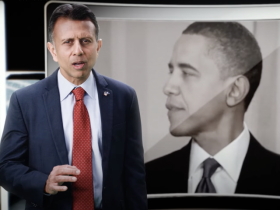“You can’t make this stuff up. Eight of the top ten murder states, in terms of the increase in murder rates, are all red states.”
— Gov. Gavin Newsom (D-Calif.), in an interview on the “No Lie with Brian Tyler Cohen” podcast, April 9
An earlier version of this article expressed death rates in a 1967 CDC report as percentages, not raw numbers. It has been corrected.
Newsom made these remarks in the course of a broad discussion with Cohen that “red” states — those that voted for Donald Trump — do more poorly than “blue” states that supported President Biden in the 2020 election. He tweeted an excerpt from the interview — which has been viewed more than 3 million times — with a line with a little less nuance: “8 of the top 10 murder states are red.”
Newsom’s point is that states that supported Biden have a good story to tell and should go on the offense against Republicans who decry rising crime rates. “How are we losing these debates?” he said. “We got to go on the offense.”
According to Newsom spokesman Nathan Click, Newsom’s statistics are derived from reports released in 2022 and this year by Third Way, a left-leaning policy group, about the “red state murder problem.” The first report, using annual crime statistics released by state governments, said eight of the 10 states with the highest murder rates in 2020 voted for Trump. The most recent report, relying on data from the Centers for Disease Control and Prevention, concluded that “solidly red states have dominated the top 10 murder rate states for the past decade — some for each of the last 21 years.”
The CDC data shows that in 2019, eight of the top 10 states voted for Trump; in 2020, seven of the top 10 did. The report said the gap in murder rates between red and blue states has widened, from a low of a nine percent gap in 2003 and 2004 to a high of 44 percent in 2019.
But there’s an interesting pattern when you look at the top 10 states. Experts question whether politics, as opposed to social conditions, is a deciding factor in the high homicide rates — though, of course, social conditions can be reflected in the politics of a state.
First of all, using the 2020 electoral college map as a proxy for blue and red states glosses over whether Democrats or Republicans run individual states.
The top 10 states by murder rate in 2020 were Mississippi, Louisiana, Alabama, Missouri, Arkansas, South Carolina, Tennessee, Illinois, Maryland and Georgia. The last three are listed by Third Way as “blue” states, though Georgia only narrowly voted for Biden in 2020.
In fact, 2020 was the first time since 1992, when Southern Democrat Bill Clinton was on the ballot, that Georgia supported a Democrat for president. The political leaders running the state are all Republicans (even if both senators are Democrats). So it’s questionable whether Georgia is really blue. Meanwhile, Maryland had a Republican governor in 2020. But it’s also listed by Third Way as blue because its electoral votes went to Biden.
The noteworthy fact about the top 10 list is that, with the exception of Illinois, all of these states during the Civil War were either in the Confederacy or were border states (Missouri and Maryland). Yes, the war ended more than 150 years ago. But a cultural milieu can take a long time to change.
We dug into the records to see which states would have ranked in the top 10 in terms of homicide rates in 1960 and 1965. In 1965, six of the same states would be on the list: Louisiana, Mississippi, Alabama, Georgia, South Carolina and Tennessee. The same would hold true for the three-year period of 1959-1961, according to a 1967 CDC report.
The 1967 CDC report broke up the statistics by region — and the area with the highest murder rates were in the old Confederacy. The three regions that include the Confederacy and border states had murder rates per 100,000 people of 7.3, 8.2 and 8.3 — compared with a national average of 4.7. The South brought up the average for the rest of the country; New England, for instance, had a rate of 1.4 and the Pacific Coast had a rate of 3.8.
In the 1960s, the electoral college geography was much different from what it is today. Much of the South, now red, solidly voted for Democrats — back when segregationists had an important power base in the party. The Pacific Coast, now considered a blue bastion, usually voted for Republicans.
Criminologists are not surprised by this pattern. “If politics plays a role, it’s a minor role,” said Tod Burke, a former police officer and professor emeritus in the Department of Criminal Justice at Radford University. He said the South traditionally has had higher poverty rates, more economic disadvantages and a culture of guns that leads to more violence. He also said that even the weather may play a bigger role than politics. “Tempers are more likely to flare when it’s hot,” he said. (A 2012 Harvard study, based on 50 years of weather and crime data for 2,972 U.S. counties, found a linear relationship between hot weather and violent crime.)
“The most common criminology explanation is probably the ‘subculture of violence’ theory — which argues that those who migrated to the South (especially from Scotland) brought with them cultural values that put a huge premium on protecting respect — which among other things resulted in the ‘dueling culture,’” Gary LaFree, a professor in the Criminology and Criminal Justice Department at the University of Maryland, said in an email.
Elijah Anderson, a Yale University sociology professor and author of “Code of the Street,” agreed that a subculture of violence plays a large role. “Basically the politics doesn’t matter much,” Anderson said. “It is the social conditions that impacts this violence.” He said that residents of Southern states have traditionally been skeptical of state authority and the criminal justice system and take matters into their own hands. He said the stereotype of the feud between the Hatfields and the McCoys in the late 1800s to some extent still holds true.
A 1996 study on the Southern “culture of honor,” published in the Journal of Personality and Social Psychology, described three experiments in which White males attending the University of Michigan were insulted by a friend who bumped into them. Northerners tended to shrug off the insult but “southerners were (a) more likely to think their masculine reputation was threatened, (b) more upset (as shown by a rise in cortisol levels), (c) more physiologically primed for aggression (as shown by a rise in testosterone levels), (d) more cognitively primed for aggression, and (e) more likely to engage in aggressive and dominant behavior.”
Jim Kessler, Third Way’s executive vice president for policy and co-author of the reports, said the group produced them in response to what he described as a drumbeat of false claims about high crime in blue states in Republican television ads and on right-wing media. He said that few people have direct experience with crime, and so they are mainly exposed to it through the media, which decides what crimes to highlight on television. So the group set out to challenge perceptions framed by the media.
“For most people, this was a shock,” said Kessler, who is not related to The Fact Checker. He believes that widespread gun ownership, higher poverty rates, lower educational attainment and less spending on social services — attributes of states that largely voted for Trump — are the primary reasons for higher murder rates. The six states that made the top 10 list in the 1960s are today among the 12 states with the highest poverty rates.
He acknowledged, however, that the pattern is not always consistent. High gun ownership or poverty does not always equate to high murder rates. For instance, Idaho, a Trump state, is in the bottom six for homicide, according to the CDC. It has the fourth-highest gun ownership and ranks 35th for poverty.
In response to critics who say the murder rates in red states are high because of “blue” cities run by Democrats (such as St. Louis and Kansas City in Missouri or New Orleans in Louisiana), Kessler said the list does not change if the county that contains the largest city in each state is removed from the data. He also argues that in many red states, Democratic-leaning areas often are starved for funding, making it harder to combat crime.
Kessler dismissed the fact that the patterns have been similar for decades. “An Alabama with George Wallace as governor is not the same state that voted for Democrats back then,” he said.
Click, Newsom’s spokesman, said in an email that his point is that “Fox News and Republicans are lying when they try to paint blue states like California or New York as lawless, violent crime capitals of America.” As for historical patterns, he said, “The same report cited above notes that the murder rate in these red states and blue states have widened over the last two decades.”
The political geography was more jumbled 60 years ago. Since then, conservative Democrats became Republicans and liberal Republicans became Democrats. New England became solidly Democratic, while the South became a Republican stronghold. Fewer states today even have senators from different parties — or vote differently from presidential election to presidential election.
Newsom’s use of the 2020 electoral map to make his case leaves out important context — that many of the states on the top 10 list today have been on the list for decades, regardless of whether they voted for the Republican candidate for president. As the country splits increasingly into red and blue zones, a possible widening of the gap in murder rates could become a more relevant marker in different styles of governance.
(About our rating scale)
Send us facts to check by filling out this form
Sign up for The Fact Checker weekly newsletter
The Fact Checker is a verified signatory to the International Fact-Checking Network code of principles








